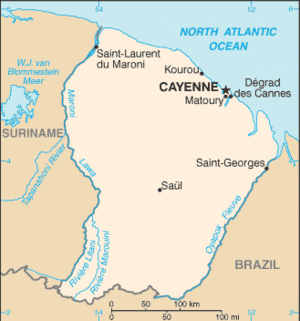Guianese Creole
| French Guianese Creole | |
|---|---|
| guyanais, patois | |
| Native to | French Guiana |
Native speakers | 50 000 [1] - 58 000[2] (2004)[3] |
|
French Creole
| |
| Language codes | |
| ISO 639-3 |
gcr |
| Glottolog |
guia1246[4] |
| Linguasphere |
51-AAC-cda to -cdd) |

French Guianese Creole is a French-lexified creole language spoken in French Guiana, and to a lesser degree, in Suriname and Guyana. It resembles Antillean Creole, but there are some lexical and grammatical differences between them. Antilleans can generally understand French Guianese Creole, though the notable differences between the French creole of French Guiana and those of the rest of the Atlantic may cause some instances of confusion. The differences consist of more French and Brazilian Portuguese influences (due to the proximity of Brazil and Portuguese presence in the country for several years.) There are also words of Amerindian and African origin. There are Guianese communities in Suriname and Guyana who continue to speak French Guianese Creole.
It should not be confused with the Guyanese Creole language, based on English, spoken in nearby Guyana.
History
French Guiana's population of 250,109 (January 2013 est.) most of whom live along the coast, is very ethnically diverse. At the 2011 census, 56.5% of the inhabitants of French Guiana were born in French Guiana, 9.3% were born in Metropolitan France, 3.4% were born in the French Caribbean départements (Guadeloupe and Martinique), and 30.5% were born in foreign countries (primarily Suriname, Brazil, Haiti, St. Lucia and Dominica).[5]
Estimates of the percentages of French Guiana ethnic composition vary, a situation compounded by the large proportion of immigrants. Mulattoes (people of mixed African and French ancestry), are the largest ethnic group, though estimates vary as to the exact percentage. Generally the Creole population is judged to be about 60 to 70% of the total population if Haitians (comprising roughly one-third of Creoles) are included, and 30 to 50% without. There are also smaller groups from various Caribbean islands, mainly Martinique, Guadeloupe, Saint Lucia as well as Dominica.
Orthography and phonology
French Guianese Creole is largely written using the French alphabet, with only a few exceptions. 'Q' and 'X' are replaced by 'k' and 'z' respectively. 'C' is not used apart from in the diagraph, ch, where it stands for [ʃ] (the word for horse is chouval, similar to French's cheval.) Otherwise, it is replaced by 'k' when it stands for [k] (Standard French's comment (why) is written kouman) and 's', when it stands for [s]. Silent 'h' is never written, unlike in Standard French, where it remains for etymological purposes.
Examples
| French Guiana Creole (IPA) | Metropolitan French | English |
|---|---|---|
| Bonswè /bonswɛ/ | Bonsoir | Good evening |
| Souplé /suː plɛ/ | S'il vous plaît | Please |
| Mèsi /mɛsi/ | Merci | Thank you |
| Mo /mɔ/ | Moi, me, je | Me, I |
| To /tɔ/ | Toi, te, tu | You |
| Li /li/ | Lui, le, la | Him, her |
| Roun /ruːn/ | Un, une | One |
| Eskizé mo /esˈkizɛ mɔ/ | Excusez-moi | Excuse me, pardon me |
| Lapli ka tonbé /laˈpliː ka tombɛ/ | Il pleut | It's raining |
| Jod-la a roun bèl jou /ʒodˈla a ruːn bel ʒu/ | Aujourd'hui, il fait beau | Today is a beautiful day |
| A kouman to fika? /a kumã to fika/ | (Comment) ça va? | How are you? |
| Ann a mo manman /an a mɔ ˈmãmã/ | Anne est ma mère | Anne is my mother |
| Andy a to frè /andi a tɔ frɛ/ | Andy est ton frère | Andy is your brother |
| I ka alé laplaj /i ka:lɛ laˈplaʒ/ | Il va à la plage | He's going to the beach |
| Mo pa mélé /mɔ pa mɛlɛ/ | Je m'en moque | I don't care |
References
- ↑ http://www.sorosoro.org/le-creole-guyanais
- ↑ Langues et Cité - Les langues en Guyane - Mai 2004
- ↑ French Guianese Creole at Ethnologue (18th ed., 2015)
- ↑ Hammarström, Harald; Forkel, Robert; Haspelmath, Martin; Bank, Sebastian, eds. (2016). "Guianese Creole French". Glottolog 2.7. Jena: Max Planck Institute for the Science of Human History.
- ↑ INSEE. "Fichier Données harmonisées des recensements de la population de 1968 à 2011" (in French). Retrieved 25 October 2014.